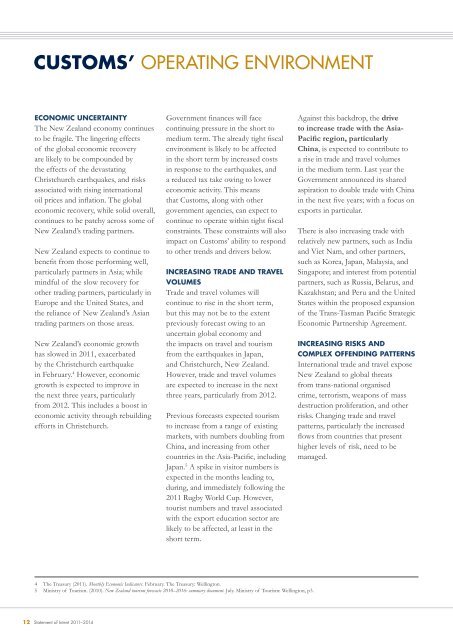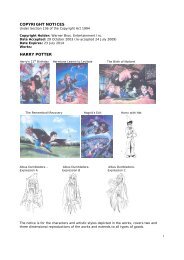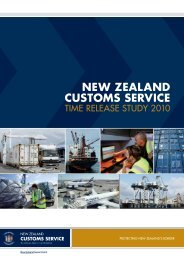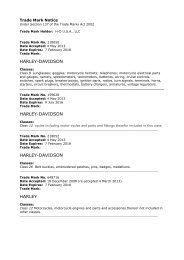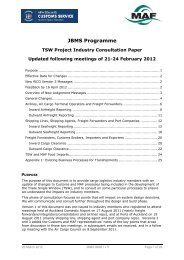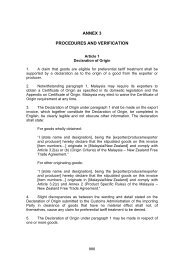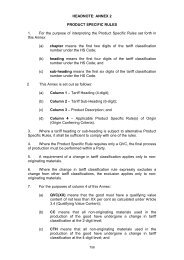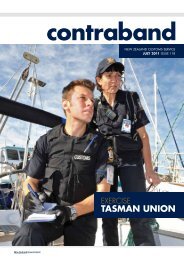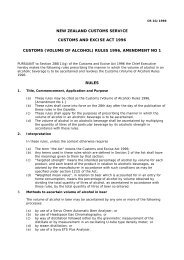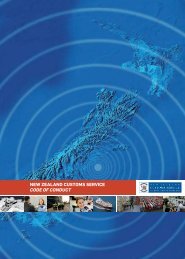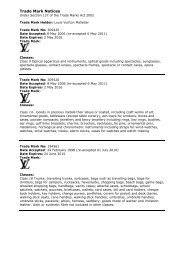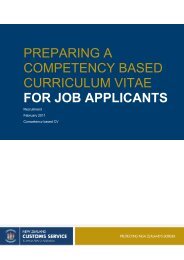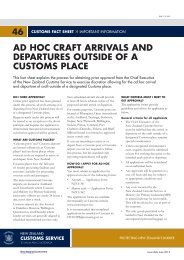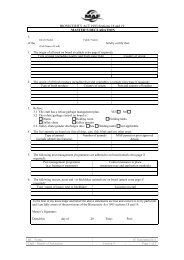Statement of Intent 2011-2014 - New Zealand Customs Service
Statement of Intent 2011-2014 - New Zealand Customs Service
Statement of Intent 2011-2014 - New Zealand Customs Service
Create successful ePaper yourself
Turn your PDF publications into a flip-book with our unique Google optimized e-Paper software.
CUSTOMS’ OPERATING ENVIRONMENTECONOMIC UNCERTAINTYThe <strong>New</strong> <strong>Zealand</strong> economy continuesto be fragile. The lingering effects<strong>of</strong> the global economic recoveryare likely to be compounded bythe effects <strong>of</strong> the devastatingChristchurch earthquakes, and risksassociated with rising internationaloil prices and inflation. The globaleconomic recovery, while solid overall,continues to be patchy across some <strong>of</strong><strong>New</strong> <strong>Zealand</strong>’s trading partners.<strong>New</strong> <strong>Zealand</strong> expects to continue tobenefit from those performing well,particularly partners in Asia; whilemindful <strong>of</strong> the slow recovery forother trading partners, particularly inEurope and the United States, andthe reliance <strong>of</strong> <strong>New</strong> <strong>Zealand</strong>’s Asiantrading partners on those areas.<strong>New</strong> <strong>Zealand</strong>’s economic growthhas slowed in <strong>2011</strong>, exacerbatedby the Christchurch earthquakein February. 4 However, economicgrowth is expected to improve inthe next three years, particularlyfrom 2012. This includes a boost ineconomic activity through rebuildingefforts in Christchurch.Government finances will facecontinuing pressure in the short tomedium term. The already tight fiscalenvironment is likely to be affectedin the short term by increased costsin response to the earthquakes, anda reduced tax take owing to lowereconomic activity. This meansthat <strong>Customs</strong>, along with othergovernment agencies, can expect tocontinue to operate within tight fiscalconstraints. These constraints will alsoimpact on <strong>Customs</strong>’ ability to respondto other trends and drivers below.INCREASING TRADE AND TRAVELVOLUMESTrade and travel volumes willcontinue to rise in the short term,but this may not be to the extentpreviously forecast owing to anuncertain global economy andthe impacts on travel and tourismfrom the earthquakes in Japan,and Christchurch, <strong>New</strong> <strong>Zealand</strong>.However, trade and travel volumesare expected to increase in the nextthree years, particularly from 2012.Previous forecasts expected tourismto increase from a range <strong>of</strong> existingmarkets, with numbers doubling fromChina, and increasing from othercountries in the Asia-Pacific, includingJapan. 5 A spike in visitor numbers isexpected in the months leading to,during, and immediately following the<strong>2011</strong> Rugby World Cup. However,tourist numbers and travel associatedwith the export education sector arelikely to be affected, at least in theshort term.Against this backdrop, the driveto increase trade with the Asia-Pacific region, particularlyChina, is expected to contribute toa rise in trade and travel volumesin the medium term. Last year theGovernment announced its sharedaspiration to double trade with Chinain the next five years; with a focus onexports in particular.There is also increasing trade withrelatively new partners, such as Indiaand Viet Nam, and other partners,such as Korea, Japan, Malaysia, andSingapore; and interest from potentialpartners, such as Russia, Belarus, andKazakhstan; and Peru and the UnitedStates within the proposed expansion<strong>of</strong> the Trans-Tasman Pacific StrategicEconomic Partnership Agreement.INCREASING RISKS ANDCOMPLEX OFFENDING PATTERNSInternational trade and travel expose<strong>New</strong> <strong>Zealand</strong> to global threatsfrom trans-national organisedcrime, terrorism, weapons <strong>of</strong> massdestruction proliferation, and otherrisks. Changing trade and travelpatterns, particularly the increasedflows from countries that presenthigher levels <strong>of</strong> risk, need to bemanaged.4 The Treasury (<strong>2011</strong>). Monthly Economic Indicators. February. The Treasury: Wellington.5 Ministry <strong>of</strong> Tourism. (2010). <strong>New</strong> <strong>Zealand</strong> tourism forecasts 2010–2016: summary document. July. Ministry <strong>of</strong> Tourism: Wellington, p3.12 <strong>Statement</strong> <strong>of</strong> <strong>Intent</strong> <strong>2011</strong>–<strong>2014</strong>


